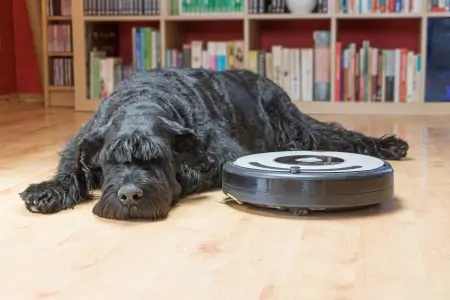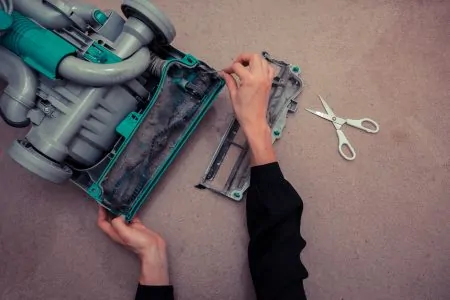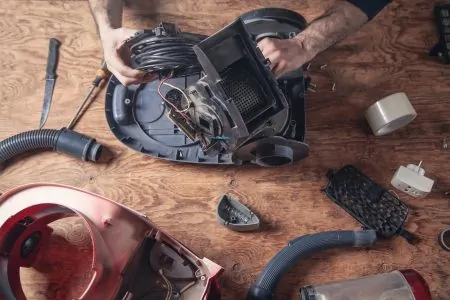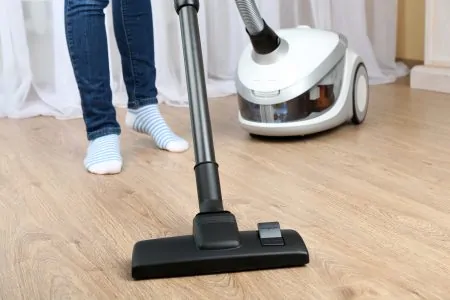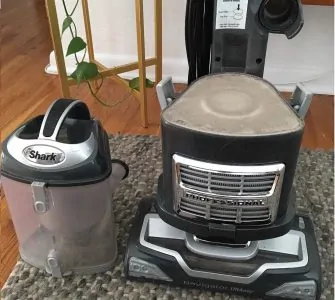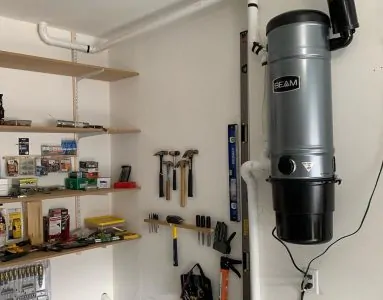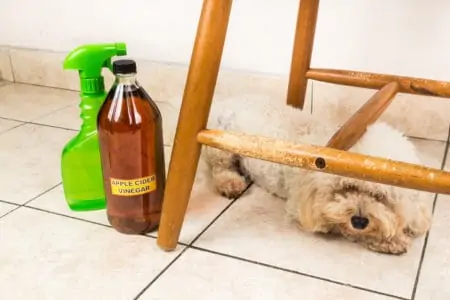Does your dog kick up a storm or scoot out of the room whenever you start the vacuum cleaner? This behavior may seem weird to us humans because we know it’s nothing to be afraid of.
The house can’t remain messy, but we also don’t want to make our furry friends uncomfortable. We’ll walk you through some of the reasons why your dog is scared of the vacuum and what we can do about it.
Every day is a school day, so we’re sure you’ll learn some interesting facts about why your dog acts like the vacuum is a thunderous Godzilla that’s just invaded your home.
Key Takeaways
- Dogs have exceptional hearing, which makes vacuum cleaners sound louder and more intense to them.
- Reasons for their fear include loud noise, unpleasant smells, lack of socialization, and individual personality traits.
- Signs of fear may include drooling, yawning, urinating, hiding under furniture, and destructive chewing.
- To help your dog overcome their fear, try desensitization techniques, keep the vacuum in an open space, start small, and reward calm behavior.
How Loud Can Your Dog Hear?
Compared to humans, a dog’s hearing is exceptional. They can pick up very high and low sounds that the human ear simply can’t detect.
On average, a human adult can’t detect sounds that exceed 20,000 Hertz (Hz). On the other hand, dogs pick up high-pitched frequencies of between 47,000 and 65,000 Hz (1).
“Hertz” refers to the measurement of sound frequency, while decibels (dB) measure the intensity or loudness of sound. This increased hearing capacity exposes your dog to intensities you can’t possibly imagine.
Closer to home, most vacuum cleaners are extremely loud to some people, with a sound level of around 70 dB (2). This noise level is often irritating for us, so imagine how that feels to your dog’s ears.
Reasons Why Dogs Are Scared of Vacuums
Understanding these reasons may make you more sympathetic and less annoyed with your dog.
1. Noise
With their heightened hearing ability, it’s normal for dogs to be scared of loud noises, including the vacuum. The amplified and sudden sound may cause distress, anxiety, and a whole lot of discomfort for your dog.
A dog not used to loud noises may associate these fearful feelings with the vacuum. Therefore, it will panic every time you bring it out.
2. Smell
Alongside hearing, dogs also have a keen sense of smell. As the vacuum cleaner lifts dirt, fur, and other debris from the carpet, it also kicks up odors. This may lead to an unpleasant sensory overload for your dog.
3. Your Dog Isn’t Socialized
Dogs that weren’t exposed to different noises and environments as puppies may have a hard time around vacuums. Reputable breeders will expose dogs to various sounds, textures, and environments to make them well-rounded.
4. It’s in the Genes
Dogs have individual personalities. Some will come across as shy and nervous at the sight of the vacuum. Whereas others may exhibit aggressive behavior when exposed to strange people or objects.
They may growl, snarl, bark, lunge, snap, and even bite the aggressor — in this case, the vacuum cleaner (3).
Signs Your Dog Is Frightened
Dogs display different signs if they are scared of vacuum cleaners. As mentioned above, some may become aggressive and extremely territorial. They see the vacuum as an enemy and feel it’s their job to guard you and your home.
Here are some of the typically fearful behaviors that your dog displays.
1. Drooling and Yawning
Dogs sometimes drool when they’re stressed. If you notice your dog yawning and drooling excessively whenever you start vacuuming, it may be a sign of nervousness (4).
2. Urinating
Dogs urinate when they’re excited, when they’re marking territory or when answering the call of nature. However, there is a problem when a well-trained dog urinates at an inappropriate moment.
Submissive urination occurs when the dog feels anxious or acknowledges a more dominant figure. This is usually a sign that the dog poses no threat to its supposed aggressor.
The loud noise from a running vacuum cleaner can result in this type of urination. Dogs may release small amounts of pee or a large puddle around the house. If you come across this, it may indicate that they’re scared of the vacuum.
3. Hiding Under Furniture
Fear invokes one of two reactions in humans and animals — fight or flight. If your dog runs under the table, chair, or other furniture whenever you switch on the vacuum, it’s a strong sign of fear. Hiding under furniture makes the dog feel safe.
4. Destructive Chewing
Destructive chewing can be triggered by vacuum anxiety. Do you find your dog chewing on cords or wires? Are your armchairs gnawed at or the pillows torn open?
Monitor your dog closely to observe when destructive chewing occurs. Dogs that embark on destructive behaviors around the vacuum cleaner are reacting to a feeling of unease (5).
Should You Throw Away Your Vacuum?
You’re probably feeling ready to throw away your vacuum cleaner now, aren’t you? But, you shouldn’t discard it. Here’s why:
- Your dog needs to learn: If you take away the vacuum, how will your dog get accustomed to loud noises? Trust me, they will encounter several in their lifetime.
- You need a clean home: Vacuums are effective cleaners, particularly if you have a shedding dog. Without one, you may have a house full of fur, which may put your health at risk.
- Remove flea eggs and larvae: More importantly, carpets, rugs, and couches are a haven for dog flea eggs and larvae. Vacuuming is the best way to suck them up and out of your home (6).
What should you do then? There are several ways to help your dog or pup overcome their fear of vacuums.
Dealing With Your Dog’s Fear
Socialization plays a significant role in how much noise your dog can handle. So, managing your dog’s fear starts with preparing them for the sounds they might encounter in daily life. Of course, this may be harder for older dogs.
Working With a Puppy
The best time to train your pup and expose them to new and different experiences is around the age of seven weeks to four months. If you buy your pup from a reputable breeder, you may find that the process started earlier than seven weeks (7).
If your vacuum cleaner has suction settings, start by adjusting it to the lowest setting. Turn it on for a couple of seconds at a time in the presence of your pup. Watch their reaction and praise them for staying calm.
Gradually increase the time and up the suction settings. Always offer them a special treat for staying calm to reinforce the good behavior.
Desensitizing an Older Dog
An old dog can learn a new trick after all. Desensitization involves making the dog less sensitive to sounds, people, or objects that trigger an exaggerated emotional reaction.
Start by exposing them to a weaker version of the thing they fear in a non-threatening way. Over time, the dog may get used to the weakened version of the feared sound.
Gradually increase the vacuum’s intensity until you reach the normal sound exposure (8). Here are some ways to desensitize your dog to vacuums:
1. Keep the Vacuum in an Open Space
Storing the vacuum cleaner in enclosed storage keeps your space neat but doesn’t do much for your dog. Keeping it in an open area, instead, will give your dog the opportunity to sniff around it and get used to it.
Similarly, if your dog wants to check out the vacuum while you’re cleaning, allow them. It may aid the acceptance of the device.
If your dog doesn’t want to be near the device, don’t force them. This will only exacerbate their fears. Remember, the acceptance process is gradual.
2. Keep Your Vacuum Cleaner Low to the Ground
When the vacuum is low to the ground, it becomes less imposing to your dog. This eliminates the feeling of dominance. It also makes it easy for the dog to investigate the vacuum.
Additionally, switch on the vacuum for a short time occasionally when you’re not cleaning your house. This will familiarize the dog with the sound and noise.
3. Start Small
Turn the vacuum cleaner on for only a few minutes at a time. Move your dog to another room. Where possible, ask a family member or friend to help note the dog’s reaction.
If your dog is okay with the vacuum from a distance, slowly approach the space they are in. Leave a clear path to the door in case the dog chooses to leave the room. You may need to repeat the process a few times before your dog gets used to it.
4. Placing Yummy Treats on the Vacuum
Consider placing treats on the vacuum cleaner to help change your dog’s perception of the device. It then becomes less of a threat and more rewarding.
Similarly, reward your dog with a treat if they remain calm after you have finished using the vacuum. They may even start wagging their tail whenever they see the device.
5. Distract Your Dog
Does your dog have a favorite toy? Place it close to the vacuum cleaner to help make your dog more comfortable around the device. You can also offer your dog their favorite toy while the vacuum is running.
While you’re cleaning, you can ask a family member to distract the dog by playing with them. If the dog can’t concentrate, don’t force them to continue playing.
6. The “Don’ts”
Understandably, you want to get this chore over with, and like many of us, you may be pressed for time. Remember, fear is not a sign of disobedience but rather a behavioral issue. Whatever you do, here are some “don’ts” to keep in mind:
- Don’t tie up the dog or lock them up in their crate: They may injure themselves as they try to get away from the scary sound. They could end up associating the sound with punishment which isn’t helpful.
- Don’t force them to endure the sound: Remember, their hearing is more magnified than yours, which will only increase their fears.
- Avoid fussing over them: They may get the impression that acting all stressed will get them special attention and treats (9).
FAQs
In Summary
Like us, dogs have different personalities, temperaments, and experiences that shape their reactions.
Following the tips above may help your dog overcome their fear of the vacuum. If your dog is still fearful, you may need to consult a canine behavioral specialist. The specialist may detect the underlying issue and offer possible solutions.
Overall, there are ways to familiarize your dog with the vacuum so that you have both a happy pup and a clean home.
